A Future-Proof Built Environment through Regenerative and Circular Lenses—Delphi Approach for Criteria Selection
Abstract
1. Introduction
- Non-transparent top-down approaches with limited or non-existent public participation,
- Reduced and unbalanced consideration of sustainability pillars, with no measures to enforce basic sustainability aspects and address intergenerational aspects,
- Complexity, rigidity, and excessive prescriptiveness,
- Limited flexibility to respond to boundary and local context issues
- Reduced interlinkages between indicators,
- Limited alignment between methodologies of different tools,
- Poor post-occupancy monitoring of performance levels.
1.1. Circular Economy Frameworks for the Built Environment
- No consultation with experts or stakeholders.
- Specific for one project or typology.
- Focus exclusively or mainly on resources and flows management, with an increasing but yet reduced consideration of other sustainability-related scopes.
- No specific metrics included.
1.2. A Framework for a Regenerative Circularity for the Built Environment (RC4BE)
- “a circular metabolism of urban flows and stocks based on the fair share and regeneration of resources.
- adaptive-resilient and high-quality urban systems that adapt to and recover from future conditions, and provide liveable, accessible, and safe urban spaces to reconnect citizens and promote sustainable lifestyles.
- healthy and bioconnected urban ecosystems that promote the reconnection between humans and nature, the stewardship and regeneration of urban and non-urban ecological systems, and the support of nature-inspired solutions, thus enabling the provision of ecosystem services sustainably into the future.
- good governance and thriving communities that stimulate a just management of natural, social, and economic capital, with inclusive, equitable, and collaborative community participation, access to knowledge, and regenerative local economies and livelihoods.
- all based on systemic approach and positive impact that, through integrated planning, embrace life cycle thinking, respect the local and global social and ecological boundaries, and create value for all” [41] (p. 11).
2. Materials and Methods
2.1. Consultation Process (Delphi Technique)
2.2. Mapping and Pre-Selection of Criteria
2.3. Experts’ Panel, Questionnaire, and Analysis Conditions
- Ranking of criteria within each category.
- General ranking of categories.
- General ranking of themes.
3. Results
3.1. Pre-Selection of Criteria
3.2. Framework Proposed for Consultation
3.3. Demographics
3.4. Criteria
3.5. Results Per Theme
- Reclaim underused spaces for free or low-cost healthy food production.
- Reclaim underused spaces for food production.
- Prioritise abundant resources.
- Parking restrictions in public spaces.
- Provide public parking spaces dedicated to Personal Electric Vehicles.
- Free Wi-Fi in public areas.
- Monitor/exhibit real-time local weather conditions to citizens.
- Monitor/exhibit real-time sound levels to citizens.
4. Discussion
4.1. Flows and Stocks (F&S)
4.2. Urban Systems (US)
4.3. Outdoor Environmental Quality (OEQ)
4.4. Bioconnectivity (BIO)
4.5. Local Community and Economy (LCE)
5. Conclusions
- A better integration of social aspects, particularly through participatory planning and co-design,
- a set of metrics to support the implementation and performance monitoring, which should also evaluate if a scoring and weighting system to allow for benchmarking between projects should be adopted,
- a consideration of the ecological externalities, or the impacts from the community outside its boundaries [159]
- a matrix identifying synergies between criteria, and a detailed analysis of their linkages with relevant global initiatives, as the Sustainable Development Goals, and
- an action framework, to support the implementation and operation of regenerative and circular neighbourhoods, based on the idea that the complexity and ever-evolving nature of neighbourhood transitions requires a process-based approach [154].
Supplementary Materials
Author Contributions
Funding
Institutional Review Board Statement
Informed Consent Statement
Data Availability Statement
Acknowledgments
Conflicts of Interest
Appendix A. List of Tools and Frameworks
| Ref. | Tool or Framework | |
|---|---|---|
| [160] | DGNB-UD Urban Districts | |
| [163,164] | LFC LEED for Cities and Communities 4.1|existing|plan and design | |
| [165] | LEED-ND Neighborhood Development | |
| [166] | CASBEE-UD Urban Development 2014 | |
| [167] | CASBEE-City 2012 | |
| [168] | Green Star Communities v1.1 | |
| [169] | EcoDistricts Protocol v1.3 | |
| [170] | Well Communities v2 | |
| [171] | Fitwel Community 2.1 | |
| [172] | OPC—One Planet Communities | |
| [173] | LCC—Living Community Challenge 1.2 | |
| [174] | LENSES Framework | |
| [175] | SITES v2 | |
| [176] | AQUA-HQE for Urban Planning | |
| [177] | Envision ISI v3 | |
| [178] | IS Infrastructure Sustainability Australia v2.0 | |
| [179] | CEEQUAL v6 International | |
| [180] | Regenerate App | |
| [181] | Doughnut Economics: Thriving City Portrait (TCP) | |
| [182] | EU Monitoring framework for CE | |
| [183] | Circular Economy Action Plan—Construction and buildings | |
| [184] | CIRCuIT—Circular Construction in Regenerative Cities | |
| [185] | Measuring Scotland’s progress towards a circular economy to help combat the climate emergency v1 | |
| [186] | Circular City Netherlands | |
| [187] | C2C for BE principles | |
| [30] | Metabolic CE indicators for infrastructure (NL) | |
| [188] | Framework for Circular Building (for BREEAM NL) | |
| [189] | Metabolic—measurement framework to track circular progress—Metro Amsterdam | |
| [190] | Level(s) | |
| [24] | Roadmap for Helsinki’s circular and sharing economy | |
| [29] | Port Cities—criteria and indicators of circularity in the built environment sector | |
| [31] | London circularity indicators (Measuring London’s progress towards becoming a more circular city) | |
| [191] | Urban Agenda Indicators for circular economy (CE) transition in cities v4 | |
| [192] | Amsterdam Circular Monitor | |
| [193] | GCE Green and circular economy Barcelona | |
| [194] | ROCK Project: Circular city—A methodological approach for sustainable districts and communities | |
| [195] | CCAF Circular City Analysis Framework Porto | |
| [196] | Opportunity-spaces for self-regenerative processes | |
| [197] | Creating circular neighbourhoods | |
| [198] | Circular City Index Italy | |
| [32] | Circular City Actions Framework | |
| [33] | Circle City Scan Tool | |
| [34] | EMF/ARUP Circular Economy in Cities Project Guide | |
| [199] | Urban Metabolism as Framework for Circular Economy Design for Cities | |
References
- IPCC. Climate Change 2022: Mitigation of Climate Change: Contribution of Working Group III to the Sixth Assessment Report of the Intergovernmental Panel on Climate Change; Cambridge University Press: Cambridge, UK, 2022. [Google Scholar]
- Oke, C.; Bekessy, S.A.; Frantzeskaki, N.; Bush, J.; Fitzsimons, J.A.; Garrard, G.E.; Grenfell, M.; Harrison, L.; Hartigan, M.; Callow, D.; et al. Cities should respond to the biodiversity extinction crisis. NPJ Urban Sustain. 2021, 1, 1–14. [Google Scholar] [CrossRef]
- Persson, L.; Carney Almroth, B.M.; Collins, C.D.; Cornell, S.; de Wit, C.A.; Diamond Miriam, L.; Fantke, P.; Hassellöv, M.; MacLeod, M.; Ryberg, M.W.; et al. Outside the Safe Operating Space of the Planetary Boundary for Novel Entities. Environ. Sci. Technol. 2022, 56, 1510–1521. [Google Scholar] [CrossRef] [PubMed]
- Steffen, W.; Richardson, K.; Rockström, J.; Cornell, S.E.; Fetzer, I.; Bennett, E.M.; Biggs, R.; Carpenter, S.R.; de Vries, W.; de Wit, C.A.; et al. Planetary boundaries: Guiding human development on a changing planet. Sciencexpress 2015, 347, 1259855. [Google Scholar] [CrossRef] [PubMed]
- Raworth, K. A Doughnut for the Anthropocene: Humanity’s compass in the 21st century. Lancet Planet. Health 2017, 1, e48–e49. [Google Scholar] [CrossRef]
- Komeily, A.; Srinivasan, R.S. A need for balanced approach to neighborhood sustainability assessments: A critical review and analysis. Sustain. Cities Soc. 2015, 18, 32–43. [Google Scholar] [CrossRef]
- Lin, K.W.; Shih, C.M. The comparative analysis of neighborhood sustainability assessment tool. Environ. Plan. B Urban Anal. City Sci. 2016, 45, 90–105. [Google Scholar] [CrossRef]
- Whitfield, M. Measuring the Performance of Sustainable Communities. Strateg. Plan. Energy Environ. 2017, 36, 41–77. [Google Scholar] [CrossRef]
- Sharifi, A.; Dawodu, A.; Cheshmehzangi, A. Limitations in assessment methodologies of neighborhood sustainability assessment tools: A literature review. Sustain. Cities Soc. 2021, 67, 102739. [Google Scholar] [CrossRef]
- Sala Benites, H.; Osmond, P.; Rossi, A.M.G. Developing Low-Carbon Communities with LEED-ND and Climate Tools and Policies in São Paulo, Brazil. J. Urban Plann. Dev. 2020, 146, 4019025. [Google Scholar] [CrossRef]
- Mang, P.; Reed, B. Designing from place: A regenerative framework and methodology. Build. Res. Inf. 2012, 40, 23–38. [Google Scholar] [CrossRef]
- ISO 59004; CD—Circular Economy—Terminology, Principles and Guidance for Implementation, Committee Draft. International Standard Organisation: Geneva, Switzerland, 2022.
- Ellen MacArthur Foundation. Completing the Picture: How the Circular Tackles Climate Change. v.3. 26 September 2019. Available online: https://www.ellenmacarthurfoundation.org/assets/downloads/Completing_The_Picture_How_The_Circular_Economy-_Tackles_Climate_Change_V3_26_September.pdf (accessed on 25 June 2020).
- Wijkman, A.; Skånberg, K. The Circular Economy and Benefits for Society: Jobs and Climate Clear Winners in an Economy Based on Renewable Energy and Resource Efficiency. A study pertaining to Finland, France, the Netherlands, Spain and Sweden. Club of Rome. 2017. Available online: https://clubofrome.org/wp-content/uploads/2020/03/The-Circular-Economy-and-Benefits-for-Society.pdf (accessed on 27 June 2020).
- Pathak, M.; Slade, R.; Pichs-Madruga, R.; Ürge-Vorsatz, D.; Shukla, P.R.; Skea, J.; Abdulla, A.; Al Khourdajie, A.; Babiker, M.; Bai, Q.; et al. Technical Summary. In Climate Change 2022: Mitigation of Climate Change: Contribution of Working Group III to the Sixth Assessment Report of the Intergovernmental Panel on Climate Change; IPCC, Ed.; Cambridge University Press: Cambridge, UK, 2022. [Google Scholar]
- Gallego-Schmid, A.; Chen, H.-M.; Sharmina, M.; Mendoza, J.M.F. Links between circular economy and climate change mitigation in the built environment. J. Clean. Prod. 2020, 260, 121115. [Google Scholar] [CrossRef]
- Buchmann-Duck, J.; Beazley, K.F. An urgent call for circular economy advocates to acknowledge its limitations in conserving biodiversity. Sci. Total Environ. 2020, 727, 138602. [Google Scholar] [CrossRef]
- Corvellec, H. New Directions for Management and Organization Studies on Waste; Gothenburg Research Institute: Göteborg, Swede, 2015. [Google Scholar]
- Allwood, J.M. Squaring the Circular Economy. In Handbook of Recycling; Elsevier: Amsterdam, The Netherlands, 2014; pp. 445–477. ISBN 9780123964595. [Google Scholar]
- Padilla-Rivera, A.; Russo-Garrido, S.; Merveille, N. Addressing the Social Aspects of a Circular Economy: A Systematic Literature Review. Sustainability 2020, 12, 7912. [Google Scholar] [CrossRef]
- MMA Chile. Hoja de ruta para un Chile circular al 2040 [Roadmap for a circular Chile by 2040). Ministerio de Medio Ambiente. 2021. Available online: https://economiacircular.mma.gob.cl/hoja-de-ruta/ (accessed on 1 August 2021).
- LWARB. London’s Circular Economy Route Map; London Waste and Recycling Board: London, UK, 2017. Available online: https://www.lwarb.gov.uk/wp-content/uploads/2015/04/LWARB-London%E2%80%99s-CE-route-map_16.6.17a_singlepages_sml.pdf (accessed on 23 July 2020).
- Circle Economy; City of Amsterdam; Raworth, K. In Proceedings of the Building blocks for the new strategy—Amsterdam Circular 2020–2025, Amsterdam, The Netherlands. 31 May 2019. Available online: https://publish.circle-economy.com/amsterdam-city-doughnut (accessed on 29 June 2020).
- City of Helsinki. Helsinki Kiertotalousvahti [Helsinki Circular Economy Watchdog]. Available online: https://kiertotalousvahti.hel.fi/ (accessed on 4 February 2022).
- Construye2025. Hoja de ruta RCD: Economía Circular en Construcción 2035 [C&DW roadmap: Circular Economy in Construction], Santiago, Chile. 2020. Available online: https://construye2025.cl/rcd/hoja-de-ruta/ (accessed on 9 September 2021).
- Metabolic; DELVA Landscape Architects; Studioninedots. Transitioning Amsterdam to a Circular City: Circular Buiksloterham. Vision & Ambition. 2015. Available online: https://www.metabolic.nl/projects/circular-buiksloterham/ (accessed on 25 December 2022).
- Ricardo; Coreo. More than Waste Yarrabilba_CE_Strategy_Overview: A Circular Economy Strategy Overview for the Yarrabilba Community, QLD, Brisbane, Australia. 2019. Available online: https://docplayer.net/200891716-More-than-waste-a-circular-economy-strategy-overview-for-the-yarrabilba-community-qld-modular-multi-use-resource-precinct-glass-and-plastics.html (accessed on 25 December 2022).
- Turntoo. Kolding Marina City as a Show Case for Circular Area Development. 2019. Available online: https://www.readkong.com/page/marina-city-kolding-1716201 (accessed on 25 December 2022).
- Gravagnuolo, A.; Angrisano, M.; Fusco Girard, L. Circular Economy Strategies in Eight Historic Port Cities: Criteria and Indicators Towards a Circular City Assessment Framework. Sustainability 2019, 11, 3512. [Google Scholar] [CrossRef]
- Anteagroup; Metabolic. Spaarndammertunnel Circulair: Een Circulaire Potentie Analyse van de Spaarndammertunnel te Amsterdam. 2016. Available online: https://www.metabolic.nl/publications/circular-economy-indicators-infrastructure-spaarndammertunnel-amsterdam/ (accessed on 16 May 2022).
- Cambridge Econometrics. Measuring London’s Progress towards Becoming a More Circular City. 2018. Available online: https://acrplus.org/fr/climate-change/measuring-london-s-progress-towards-becoming-a-more-circular-city (accessed on 4 February 2022).
- Circle Lab for Cities. Circular City Actions Framework, Bonn, Germany. 2021. Available online: https://circulars.iclei.org/wp-content/uploads/2021/10/Circular-City-Action-Framework_V2.pdf (accessed on 4 February 2022).
- Circle Economy. Circle City Scan Tool, prototype. 2020. Available online: https://cities.circle-lab.com/ (accessed on 25 December 2022).
- Ellen MacArthur Foundation; ARUP. Circular Economy in Cities: Project Guide. 2019. Available online: https://ellenmacarthurfoundation.org/circular-economy-in-cities (accessed on 22 October 2021).
- Cole, R.J. Transitioning from green to regenerative design. Build. Res. Inf. 2012, 40, 39–53. [Google Scholar] [CrossRef]
- Bell, S.; Morse, S. Sustainability Indicators: Measuring the Immeasurable? 2nd ed.; Earthscan: London, UK; Sterling, VA, USA, 2008; ISBN 9781844072996. [Google Scholar]
- Calisto Friant, M.; Vermeulen, W.J.; Salomone, R. A typology of circular economy discourses: Navigating the diverse visions of a contested paradigm. Resour. Conserv. Recycl. 2020, 161, 104917. [Google Scholar] [CrossRef]
- Lyle, J.T. Regenerative Design for Sustainable Development; Wiley: New York, NY, USA; Chichester, UK, 1994; ISBN 0-471-55582-7. [Google Scholar]
- Reed, B. Shifting from ‘sustainability’ to regeneration. Build. Res. Inf. 2007, 35, 674–680. [Google Scholar] [CrossRef]
- Brown, K. Design for Regenerative Communities. Progress. Plan. 2012, 193, 4–8. [Google Scholar]
- Sala Benites, H.; Osmond, P.; Prasad, D. A neighbourhood-scale conceptual model towards regenerative circularity for the built environment. Sust. Dev. 2022. [Google Scholar] [CrossRef]
- Gan, X.; Fernandez, I.C.; Guo, J.; Wilson, M.; Zhao, Y.; Zhou, B.; Wu, J. When to use what: Methods for weighting and aggregating sustainability indicators. Ecol. Indic. 2017, 81, 491–502. [Google Scholar] [CrossRef]
- Taylor, E. We Agree, Don’t We? The Delphi Method for Health Environments Research. HERD 2020, 13, 11–23. [Google Scholar] [CrossRef] [PubMed]
- Alyami, S.H.; Rezgui, Y.; Kwan, A. Developing sustainable building assessment scheme for Saudi Arabia: Delphi consultation approach. Renew. Sustain. Energy Rev. 2013, 27, 43–54. [Google Scholar] [CrossRef]
- Musa, H.D.; Yacob, M.R.; Abdullah, A.M.; Ishak, M.Y. Delphi Method of Developing Environmental Well-being Indicators for the Evaluation of Urban Sustainability in Malaysia. Procedia Environ. Sci. 2015, 30, 244–249. [Google Scholar] [CrossRef]
- Lak, A.; Sharifi, A.; Khazaei, M.; Aghamolaei, R. Towards a framework for driving sustainable urban regeneration with ecosystem services. Land Use Policy 2021, 111, 105736. [Google Scholar] [CrossRef]
- Dalkey, N.; Helmer, O. An Experimental Application of the Delphi Method to the Use of Experts. Manag. Sci. 1963, 9, 458–467. [Google Scholar] [CrossRef]
- Hasson, F.; Keeney, S. Enhancing rigour in the Delphi technique research. Technol. Forecast. Soc. Change 2011, 78, 1695–1704. [Google Scholar] [CrossRef]
- Msibi, P.N.; Mogale, R.; Waal, M.d.; Ngcobo, N. Using e-Delphi to formulate and appraise the guidelines for women’s health concerns at a coal mine: A case study. Curationis 2018, 41, e1–e6. [Google Scholar] [CrossRef]
- Md Arof, A. The Application of a Combined Delphi-AHP Method in Maritime Transport Research—A Review. ASS 2015, 11, 73. [Google Scholar] [CrossRef]
- Lee, J.H.; Lim, S. An Analytic Hierarchy Process (AHP) Approach for Sustainable Assessment of Economy-Based and Community-Based Urban Regeneration: The Case of South Korea. Sustainability 2018, 10, 4456. [Google Scholar] [CrossRef]
- Sala Benites, H.; Osmond, P.; Prasad, D. Inquiry on perceptions and practices of built environment professionals regarding regenerative and circular approaches. Buildings 2023, 12, 63. [Google Scholar] [CrossRef]
- Prabhu, R.; Colfer, C.J.P.; Dudley, R.G. Guidelines for Developing, Testing and Selecting Criteria and Indicators for Sustainable Forest Management: A C&I Reference; CIFOR: Jakarta, Indonesia, 1999. [Google Scholar]
- Domingues, A.R.; Moreno Pires, S.; Caeiro, S.; Ramos, T.B. Defining criteria and indicators for a sustainability label of local public services. Ecol. Indic. 2015, 57, 452–464. [Google Scholar] [CrossRef]
- Powell, C. The Delphi technique: Myths and realities. J. Adv. Nurs. 2003, 41, 376–382. [Google Scholar] [CrossRef] [PubMed]
- Hsu, C.-C.; Sandford, B.A. The Delphi Technique: Making Sense of Consensus. Pract. Assess. Res. Eval. 2007, 12, 10. [Google Scholar]
- Fink, A. How to Conduct Surveys: A Step-by-Step Guide, 6th ed.; SAGE: Los Angeles, CA, USA, 2017; ISBN 9781483378480. [Google Scholar]
- Linstone, H.A.; Turoff, M. (Eds.) The Delphi Method: Techniques and Applications; Addison-Wesley: Boston, MA, USA, 1975. [Google Scholar]
- Nunnally, J.C.; Bernstein, I.H. Psychometric Theory, 3rd ed.; McGraw-Hill: New York, NY, USA; London, UK, 1994; ISBN 0-07-047849-X. [Google Scholar]
- Giannarou, L.; Zervas, E. Using Delphi technique to build consensus in practice. Int. J. Bus. Sci. Appl. Manag. 2014, 9, 65–82. [Google Scholar]
- Kumar, S.; Bhaumik, S.; Banerji, H. Methodology for Framing Indicators for Assessing Economic-Socio-Cultural Sustainability of the Neighbourhood Level Urban Communities in Indian Megacities: Evidence from Kolkata. Soc. Indic. Res. 2021, 154, 511–544. [Google Scholar] [CrossRef]
- Pant, P.R.; Rana, P.; Pradhan, K.; Joshi, S.K.; Mytton, J. Identifying research priorities for road safety in Nepal: A Delphi study. BMJ Open 2022, 12, e059312. [Google Scholar] [CrossRef]
- Cheshire, D. Building Revolutions: Applying the Circular Economy to the Built Environment; Riba Publishing: Newcastle, Australia, 2016; ISBN 1859466451. [Google Scholar]
- Debacker, W.; Manshoven, S. D1 Synthesis Report on State-of-the-Art Analysis: Key Barriers and Opportunities for Materials Passports and Reversible Building Design in the Current System. BAMB Project—Building as Material Banks. 2016. Available online: http://www.bamb2020.eu/wp-content/uploads/2016/03/D1_Synthesis-report-on-State-of-the-art_20161129_FINAL.pdf (accessed on 30 September 2020).
- Purnell, P.; Dawson, D.; Roelich, K.E.; Steinberger, J.K.; Busch, J. Critical materials for infrastructure: Local vs global properties. Proc. Inst. Civ. Eng. Eng. Sustain. 2013, 166, 272–280. [Google Scholar] [CrossRef]
- FIEC. The Construction Industry: Raw Materials, Circular Economy and Digitalisation. Available online: https://ec.europa.eu/docsroom/documents/26484/attachments/9/translations/en/renditions/native (accessed on 10 February 2020).
- IRP. The Weight of Cities: Resource Requirements of Future Urbanization; Full report; IRP: Nairobi, Kenya, 2018. [Google Scholar]
- Johannessen, Å.; Mostert, E. Urban Water Governance and Learning—Time for More Systemic Approaches? Sustainability 2020, 12, 6916. [Google Scholar] [CrossRef]
- Wong, T.H.F.; Brown, R.R. The water sensitive city: Principles for practice. Water Sci. Technol. 2009, 60, 673–682. [Google Scholar] [CrossRef]
- Brears, R.C. Developing the Circular Water Economy; Palgrave Pivot: Cham, Switzerland, 2019; ISBN 978-3-030-32575-6. [Google Scholar]
- Stephan, A.; Athanassiadis, A. Quantifying and mapping embodied environmental requirements of urban building stocks. Build. Environ. 2017, 114, 187–202. [Google Scholar] [CrossRef]
- Nika, C.E.; Gusmaroli, L.; Ghafourian, M.; Atanasova, N.; Buttiglieri, G.; Katsou, E. Nature-based solutions as enablers of circularity in water systems: A review on assessment methodologies, tools and indicators. Water Res. 2020, 183, 115988. [Google Scholar] [CrossRef] [PubMed]
- Ariluoma, M.; Ottelin, J.; Hautamäki, R.; Tuhkanen, E.-M.; Mänttäri, M. Carbon sequestration and storage potential of urban green in residential yards: A case study from Helsinki. Urban For. Urban Green. 2021, 57, 126939. [Google Scholar] [CrossRef]
- C40 Cities. Cities100: Stockholm—World’s First Urban Carbon Sink with Biochar. Available online: https://www.c40.org/case-studies/cities100-stockholm-world-s-first-urban-carbon-sink-with-biochar/ (accessed on 25 December 2022).
- Mohareb, E.; Kennedy, C. Gross Direct and Embodied Carbon Sinks for Urban Inventories. J. Ind. Ecol. 2012, 16, 302–316. [Google Scholar] [CrossRef]
- Thomson, G.; Newman, P. Geoengineering in the Anthropocene through Regenerative Urbanism. Geosciences 2016, 6, 46. [Google Scholar] [CrossRef]
- Samaratunga, M.; Ding, L.; Bishop, K.; Prasad, D.; Yee, K.W. Modelling and Analysis of Post-occupancy Behaviour in Residential Buildings to Inform BASIX Sustainability Assessments in NSW. Procedia Eng. 2017, 180, 343–355. [Google Scholar] [CrossRef]
- Cornago, E. The Potential of Behavioural Interventions for Optimising Energy Use at Home. Available online: https://www.iea.org/articles/the-potential-of-behavioural-interventions-for-optimising-energy-use-at-home (accessed on 18 May 2022).
- Furness, W.W.; Gallaher, C.M. Food access, food security and community gardens in Rockford, IL. Local Environ. 2018, 23, 414–430. [Google Scholar] [CrossRef]
- Nicholls, E.; Ely, A.; Birkin, L.; Basu, P.; Goulson, D. The contribution of small-scale food production in urban areas to the sustainable development goals: A review and case study. Sustain. Sci. 2020, 15, 1585–1599. [Google Scholar] [CrossRef]
- Khan, M.M.; Akram, M.T.; Janke, R.; Qadri, R.W.K.; Al-Sadi, A.M.; Farooque, A.A. Urban Horticulture for Food Secure Cities through and beyond COVID-19. Sustainability 2020, 12, 9592. [Google Scholar] [CrossRef]
- Parris, K.M.; Amati, M.; Bekessy, S.A.; Dagenais, D.; Fryd, O.; Hahs, A.K.; Hes, D.; Imberger, S.J.; Livesley, S.J.; Marshall, A.J.; et al. The seven lamps of planning for biodiversity in the city. Cities 2018, 83, 44–53. [Google Scholar] [CrossRef]
- Yazdanparast, T.; Strezov, V.; Wieland, P.; Lai, Y.-J.; Jacob, D.E.; Taylor, M.P. Lead poisoning of backyard chickens: Implications for urban gardening and food production. Environ. Pollut. 2022, 310, 119798. [Google Scholar] [CrossRef]
- Beames, A.; Broekx, S.; Heijungs, R.; Lookman, R.; Boonen, K.; van Geert, Y.; Dendoncker, K.; Seuntjens, P. Accounting for land-use efficiency and temporal variations between brownfield remediation alternatives in life-cycle assessment. J. Clean. Prod. 2015, 101, 109–117. [Google Scholar] [CrossRef]
- Hassler, U.; Algreen-Ussing, G.; Kohler, N. Urban Life Cycle Analysis and the conservation of the urban fabric. SUIT Position Pap. In Langfriststabilität: Beiträge zur langfristigen Dynamik der gebauten Umwelt (Towards a sustainable development of the built environment); Hassler, U., Ed.; Institut für Denkmalpflege und Bauforschung, ETH Zürich: Zürich, Switzerland; Vdf, Hochschulverlag AG an der ETH Zürich: Zürich, Switzerland, 2011; pp. 1–7. ISBN 9783728131898. [Google Scholar]
- Eberhardt, L.; Birgisdottir, H.; Birkved, M. Comparing life cycle assessment modelling of linear vs. circular building components. IOP Conf. Ser. Earth Environ. Sci. 2019, 225, 12039. [Google Scholar] [CrossRef]
- Lavers Westin, A.; Kalmykova, Y.; Rosado, L.; Oliveira, F.; Laurenti, R.; Rydberg, T. Combining material flow analysis with life cycle assessment to identify environmental hotspots of urban consumption. J. Clean. Prod. 2019, 226, 526–539. [Google Scholar] [CrossRef]
- Sharifi, A.; Yamagata, Y. Principles and criteria for assessing urban energy resilience: A literature review. Renew. Sustain. Energy Rev. 2016, 60, 1654–1677. [Google Scholar] [CrossRef]
- Zhou, X.; Kim, J. Social disparities in tree canopy and park accessibility: A case study of six cities in Illinois using GIS and remote sensing. Urban For. Urban Green. 2013, 12, 88–97. [Google Scholar] [CrossRef]
- Rede Nossa São Paulo. Mapa da Desigualdade 2021—Mapas [Inequality Map—Maps]. 2021. Available online: https://www.nossasaopaulo.org.br/wp-content/uploads/2021/10/Mapa-Da-Desigualdade-2021_Mapas.pdf (accessed on 19 May 2022).
- Rydin, Y. Planning for Sustainability: Lessons from Studying Neighbourhood Shopping Areas. Plan. Pract. Res. 2019, 34, 522–536. [Google Scholar] [CrossRef]
- Wright Wendel, H.E.; Zarger, R.K.; Mihelcic, J.R. Accessibility and usability: Green space preferences, perceptions, and barriers in a rapidly urbanizing city in Latin America. Landsc. Urban Plan. 2012, 107, 272–282. [Google Scholar] [CrossRef]
- Lowe, M.; Whitzman, C.; Badland, H.; Davern, M.; Aye, L.; Hes, D.; Butterworth, I.; Giles-Corti, B. Planning Healthy, Liveable and Sustainable Cities: How Can Indicators Inform Policy? Urban Policy Res. 2015, 33, 131–144. [Google Scholar] [CrossRef]
- O’Leary, H. Between Stagnancy and Affluence: Reinterpreting Water Poverty and Domestic Flows in Delhi, India. Soc. Nat. Resour. 2016, 29, 639–653. [Google Scholar] [CrossRef]
- Oluwole, O.; Otaniyi, O.O.; Ana, G.A.; Olopade, C.O. Indoor air pollution from biomass fuels: A major health hazard in developing countries. J. Public Health 2012, 20, 565–575. [Google Scholar] [CrossRef]
- Bonatz, N.; Guo, R.; Wu, W.; Liu, L. A comparative study of the interlinkages between energy poverty and low carbon development in China and Germany by developing an energy poverty index. Energy Build. 2019, 183, 817–831. [Google Scholar] [CrossRef]
- Robinson, C.; Yan, D.; Bouzarovski, S.; Zhang, Y. Energy poverty and thermal comfort in northern urban China: A household-scale typology of infrastructural inequalities. Energy Build. 2018, 177, 363–374. [Google Scholar] [CrossRef]
- Pávez, J.; Barraza, C.; Durán, C.; Medina, G.; Rivera, M.I.; La Barrera, F.d. Frío, Contaminación y Hacinamiento: Un Millón de Viviendas Sociales Con Fallas Que Facilitan La Expansión Del Covid-19. CIPER Chile. Available online: https://www.ciperchile.cl/2020/11/12/frio-contaminacion-y-hacinamiento-un-millon-de-viviendas-sociales-con-fallas-que-facilitan-la-expansion-del-covid-19/ (accessed on 15 April 2021).
- Santamouris, M. On the energy impact of urban heat island and global warming on buildings. Energy Build. 2014, 82, 100–113. [Google Scholar] [CrossRef]
- Bremont. Report of the Special Rapporteur on the Promotion and Protection of the Right to Freedom of Opinion and Expression, Frank La Rue: A/HRC/17/27; United Nations Digital Library: Geneva, Switzerland, 2011. [Google Scholar]
- Idoeta, P.A. ‘Sem wi-fi’: Pandemia Cria Novo Símbolo de Desigualdade na educação. BBC News Brasil [Online]. 10 March 2020. Available online: https://www.bbc.com/portuguese/brasil-54380828 (accessed on 1 June 2022).
- Barry, J.J. COVID-19 Exposes Why Access to the Internet Is A Human Right. Available online: https://www.openglobalrights.org/covid-19-exposes-why-access-to-internet-is-human-right/ (accessed on 1 June 2022).
- Floater, G.; Rode, P.; Robert, A.; Kennedy, C.; Hoornweg, D.; Slavcheva, R.; Godfrey, N. Cities and the New Climate Economy: The Transformative Role of Global Urban Growth; New Climate Economy Paper No. 01; LSE Library: London, UK, 2014; Available online: https://lsecities.net/wp-content/uploads/2014/12/The-Transformative-Role-of-Global-Urban-Growth-01.pdf (accessed on 25 December 2022).
- Roberts, D. Making cities more dense always sparks resistance. Here’s how to overcome it. Vox [Online]. 30 January 2019. Available online: https://www.vox.com/2017/6/20/15815490/toderian-nimbys (accessed on 20 May 2022).
- Milliken, J. Urban safety and security: Lessons from the last two decades and emergent issues. In Synthesis Report of the Conference Reviewing the State of Safety in World No. 22; United Nations Framework Convention on Climate Change: New York, NY, USA, 2016; Available online: https://www.gpplatform.ch/sites/default/files/PP%2022%20-%20Urban%20safety%20and%20security_0.pdf (accessed on 25 December 2022).
- Foster, S.; Wood, L.; Christian, H.; Knuiman, M.; Giles-Corti, B. Planning safer suburbs: Do changes in the built environment influence residents’ perceptions of crime risk? Soc. Sci. Med. 2013, 97, 87–94. [Google Scholar] [CrossRef] [PubMed]
- Doan, P.L. Queers in the American City: Transgendered perceptions of urban space. Gend. Place Cult. 2007, 14, 57–74. [Google Scholar] [CrossRef]
- Iglesias, P.; Greene, M.; Dios Ortúzar, J.d. On the perception of safety in low income neighbourhoods: Using digital images in a stated choice experiment. In Choice Modelling; Hess, S., Daly, A., Eds.; Edward Elgar Publishing: Cheltenham, UK, 2013; pp. 193–210. [Google Scholar]
- Park, Y.; Garcia, M. Pedestrian safety perception and urban street settings. Int. J. Sustain. Transp. 2020, 14, 860–871. [Google Scholar] [CrossRef]
- Angeles, L.C.; Roberton, J. Empathy and inclusive public safety in the city: Examining LGBTQ2+ voices and experiences of intersectional discrimination. Women’s Stud. Int. Forum 2020, 78, 102313. [Google Scholar] [CrossRef]
- UNEP. Towards a Pollution-Free Planet: Background Report; United Nations Environment Programme: Nairobi, Kenya, 2017. [Google Scholar]
- Albertine, J.M.; Manning, W.J.; DaCosta, M.; Stinson, K.A.; Muilenberg, M.L.; Rogers, C.A. Projected carbon dioxide to increase grass pollen and allergen exposure despite higher ozone levels. PLoS ONE 2014, 9, e111712. [Google Scholar] [CrossRef]
- Ulpiani, G. On the linkage between urban heat island and urban pollution island: Three-decade literature review towards a conceptual framework. Sci. Total Environ. 2021, 751, 141727. [Google Scholar] [CrossRef]
- Pettit, T.; Irga, P.J.; Surawski, N.C.; Torpy, F.R. An Assessment of the Suitability of Active Green Walls for NO2 Reduction in Green Buildings Using a Closed-Loop Flow Reactor. Atmosphere 2019, 10, 801. [Google Scholar] [CrossRef]
- Pettit, T.; Irga, P.J.; Torpy, F.R. The in situ pilot-scale phytoremediation of airborne VOCs and particulate matter with an active green wall. Air Qual. Atmos. Health 2019, 12, 33–44. [Google Scholar] [CrossRef]
- ISO 12913-1:2014; Acoustics—Soundscape—Part 1: Definition and Conceptual Framework. International Standard Organisation: Geneva, Switzerland, 2014.
- Kang, J.; Aletta, F.; Gjestland, T.T.; Brown, L.A.; Botteldooren, D.; Schulte-Fortkamp, B.; Lercher, P.; van Kamp, I.; Genuit, K.; Fiebig, A.; et al. Ten questions on the soundscapes of the built environment. Build. Environ. 2016, 108, 284–294. [Google Scholar] [CrossRef]
- Brown, A.L. Advancing the concepts of soundscapes and soundscape planning. In Proceedings of the Australian Acoustical Society Conference, Acoustics 2011: Breaking New Ground, Gold Coast, Australia, 2–4 November 2011. [Google Scholar]
- McIntire, N.E.; Knowles-Yánez, K.; Hope, D. Urban ecology as an interdisciplinary field—Differences in the use of ‘urban’ between the social and natural sciences. Urban Ecosyst. 2000, 4, 49–65. [Google Scholar]
- Wu, J. Urban ecology and sustainability: The state-of-the-science and future directions. Landsc. Urban Plan. 2014, 125, 209–221. [Google Scholar] [CrossRef]
- Rees, W.E. Urban ecosystems: The human dimension. Urban Ecosyst. 1997, 1, 63–75. [Google Scholar] [CrossRef]
- Jansson, Å. Reaching for a sustainable, resilient urban future using the lens of ecosystem services. Ecol. Econ. 2013, 86, 285–291. [Google Scholar] [CrossRef]
- Hoornweg, D.; Sugar, L.; Trejos Gómez, C.L. Cities and greenhouse gas emissions: Moving forward. Environ. Urban. 2011, 23, 207–227. [Google Scholar] [CrossRef]
- Soanes, K.; Sievers, M.; Chee, Y.E.; Williams, N.S.G.; Bhardwaj, M.; Marshall, A.J.; Parris, K.M. Correcting common misconceptions to inspire conservation action in urban environments. Conserv. Biol. 2019, 33, 300–306. [Google Scholar] [CrossRef]
- Sala Benites, H.; Osmond, P. Bioconnections as Enablers of Regenerative Circularity for the Built Environment. UP 2021, 6, 25–39. [Google Scholar] [CrossRef]
- Dorsey, J.W. Brownfields and Greenfields: The Intersection of Sustainable Development and Environmental Stewardship. Environ. Pract. 2003, 5, 69–76. [Google Scholar] [CrossRef]
- Li, F.; Wang, R.; Paulussen, J.; Liu, X. Comprehensive concept planning of urban greening based on ecological principles: A case study in Beijing, China. Landsc. Urban Plan. 2005, 72, 325–336. [Google Scholar] [CrossRef]
- Welsch, D.J. Riparian Forest Buffers: Function and Design for Protection and Enhancement of Water Resources; United States Department of Agriculture: Washington, DC, USA, 1991. Available online: https://www.fs.usda.gov/naspf/sites/default/files/publications/01_na-pr-07-91_riparian_forest_buffers_function_and_design_for_protection_and_enhancement_of_water_resources_508c.pdf (accessed on 10 March 2021).
- Blau, M.; Luz, F.; Panagopoulos, T. Urban River Recovery Inspired by Nature-Based Solutions and Biophilic Design in Albufeira, Portugal. Land 2018, 7, 141. [Google Scholar] [CrossRef]
- IUCN. Defining Nature-Based Solutions: WCC-2016-Res-069-EN; International Union for Conservation of Nature: Honolulu, HI, USA, 2016; Available online: https://portals.iucn.org/library/sites/library/files/resrecfiles/WCC_2016_RES_069_EN.pdf (accessed on 6 September 2021).
- Pörtner, H.-O.; Roberts, D.C.; Adams, H. Technical Summary: (Complete author list). In Climate Change 2022: Impacts, Adaptation, and Vulnerability: Contribution of Working Group II to the Sixth Assessment Report of the Intergovernmental Panel on Climate Change; IPCC, Ed.; Cambridge University Press: Cambridge, UK, 2022. [Google Scholar]
- Cambridge Econometrics. Economic Costs and Benefits of Nature-Based Solutions to Mitigate Climate Change. 2020. Available online: https://www.rspb.org.uk/globalassets/downloads/documents/positions/the-economic-costs--benefits-of-nature-based-solutions_final-report_final_v3.pdf (accessed on 9 June 2021).
- Cardinali, M.; Dumitru, A.; Vandewoestijne, S.; Wendling, L. Evaluating the Impact of Nature-Based Solutions: A Summary for Policy Makers; European Commission: Brussels, Belgium, 2012; Available online: https://op.europa.eu/en/publication-detail/-/publication/aeb73167-0acc-11ec-adb1-01aa75ed71a1 (accessed on 25 December 2022).
- Manes, S.; Vale, M.M.; Malecha, A.; Pires, A.P. Nature-based solutions promote climate change adaptation safeguarding ecosystem services. Ecosyst. Serv. 2022, 55, 101439. [Google Scholar] [CrossRef]
- Silva, P.W.S.; Benites, H.S.; Monteiro, L.M.; Duarte, D.H.S. Instrumentos urbanísticos para incremento de vegetação em áreas urbanas: Análise comparada a partir da Quota Ambiental do município de São Paulo: [Planning instruments for vegetation enhancement in urban areas: Compared analysis based on São Paulo’s Environmental Quota]. In SINGEURB 2017 Cidades e Objetivos do Desenvolvimento Sustentável, [Cities and Sustainable Development Goals]; Masiero, É., Pierini, C., Eds.; Teixeira, Bernardo Arantes do Nascimento: São Carlos, Brazil, 2017; pp. 905–918. [Google Scholar]
- UN Habitat. The Global Campaign on Good Governance, 2nd ed.; Concept Paper; United Nations Human Settlements Programme: Nairobi, Kenya, 2002; Available online: https://unhabitat.org/sites/default/files/download-manager-files/Global%20Campaign%20on%20Urban%20Governance.pdf (accessed on 4 August 2021).
- Gibbons, L.V. Regenerative—The New Sustainable? Sustainability 2020, 12, 5483. [Google Scholar] [CrossRef]
- Garzillo, C.; Balanciaga, I.; Izulain, A.; Rangil-Escribano, T.; Wildman, A. Circular Governance Models for Adaptive Reuse of Cultural Heritage. CLIC project, Deliverable D3.4. 2019. Available online: https://www.clicproject.eu/files/D3-4.pdf (accessed on 1 November 2021).
- da Cruz, R.B.C.; Marins, K.R.C.C. Urban planning and popular participation: A diagnosis of the effectiveness of participatory processes applied to the revision of São Paulo master plan. Habitat Int. 2019, 88, 101987. [Google Scholar] [CrossRef]
- Chomać-Pierzecka, E.; Sobczak, A.; Urbańczyk, E. RES Market Development and Public Awareness of the Economic and Environmental Dimension of the Energy Transformation in Poland and Lithuania. Energies 2022, 15, 5461. [Google Scholar] [CrossRef]
- Almulhim, A.I.; Abubakar, I.R. Understanding Public Environmental Awareness and Attitudes toward Circular Economy Transition in Saudi Arabia. Sustainability 2021, 13, 10157. [Google Scholar] [CrossRef]
- Adams, K.T.; Osmani, M.; Thorpe, T.; Thornback, J. Circular economy in construction: Current awareness, challenges and enablers. Proc. Inst. Civ. Eng. Waste Resour. Manag. 2017, 170, 15–24. [Google Scholar] [CrossRef]
- Frantzeskaki, N. Bringing Transition Management to Cities: Building Skills for Transformative Urban Governance. Sustainability 2022, 14, 650. [Google Scholar] [CrossRef]
- Birkeland, J. Positive Development. In Designing for Hope: Pathways to Regenerative Sustainability; Hes, D., Du Plessis, C., Eds.; Routledge: New York, NY, USA, 2015; pp. 93–109. ISBN 9781138800625. [Google Scholar]
- Barton, H. City of Well-Being: A Radical Guide to Planning; Routledge Taylor & Francis Group: London, UK; New York, NY, USA, 2017; ISBN 9780415639330. [Google Scholar]
- Guldmann, E.; Huulgaard, R.D. Circular Business Model Innovation for Sustainable Development. In Innovation for Sustainability; Bocken, N., Ritala, P., Albareda, L., Verburg, R., Eds.; Springer International Publishing: Cham, Switzerland, 2019; pp. 77–95. ISBN 978-3-319-97384-5. [Google Scholar]
- Sanford, C. The Regenerative Business: How to Redesign Work, Cultivate Human Potential, and Realize Extraordinary Outcomes; Nicholas Brealey Publishing: London, UK, 2017; ISBN 978-1-47366-910-9. [Google Scholar]
- Rosado, L.; Kalmykova, Y. Combining industrial symbiosis with sustainable supply chain management for the development of urban communities. IEEE Eng. Manag. Rev. 2019, 47, 103–114. [Google Scholar] [CrossRef]
- Sala Benites, H.; Zegers Cádiz, C. Portafolio de Modelos de Negocios en Economía Circular Para la Construcción. Informe Final de la Consultoría [Portfolio of Circular Economy Business Models in Construction; Final Consultancy Report]; Iniciativa de la Hoja de Ruta RCD y Economía Circular en Construcción, PEDN 35718-5, Santiago, Chile. 2021. Available online: https://construye2025.cl/wp-content/uploads/2022/07/Portafolio-de-modelos%E2%80%A8-de-negocio-en-economia-circular-para-la-construccion-Informe-final-de-la-consultoria.pdf (accessed on 11 November 2022).
- Town of Mahone Bay. Integrated Community Sustainability Plan. 2010. Available online: https://www.townofmahonebay.ca/uploads/1/3/0/6/130665195/integrated_community_sustainability_plan.pdf (accessed on 27 May 2022).
- Djeunang Mezafack, R.A.; Di Mascolo, M.; Simeu-Abazi, Z. Systematic literature review of repair shops: Focus on sustainability. Int. J. Prod. Res. 2021, 60, 7093–7112. [Google Scholar] [CrossRef]
- Keng, Z.X.; Chong, S.; Ng, C.G.; Ridzuan, N.I.; Hanson, S.; Pan, G.-T.; Lau, P.L.; Supramaniam, C.V.; Singh, A.; Chin, C.F.; et al. Community-scale composting for food waste: A life-cycle assessment-supported case study. J. Clean. Prod. 2020, 261, 121220. [Google Scholar] [CrossRef]
- Fergutz, O.; Dias, S.; Mitlin, D. Developing urban waste management in Brazil with waste picker organizations. Environ. Urban. 2011, 23, 597–608. [Google Scholar] [CrossRef]
- Lützkendorf, T.; Balouktsi, M. Assessing a Sustainable Urban Development: Typology of Indicators and Sources of Information. Procedia Environ. Sci. 2017, 38, 546–553. [Google Scholar] [CrossRef]
- Nguyen, P.T.; Wells, S. Systemic Indicators for Rural Communities in Developing Economies: Bringing the Shared Vision into Being. Syst. Pr. Action Res 2018, 31, 159–177. [Google Scholar] [CrossRef]
- Rockström, J.; Steffen, W.; Noone, K.; Persson, Å.; Chapin, F.S.I.; Lambin, E.; Lenton, T.M.; Scheffer, M.; Folke, C.; Schellnhuber, H.J.; et al. Planetary Boundaries: Exploring the Safe Operating Space for Humanity. Ecol. Soc. 2009, 14, 32. [Google Scholar] [CrossRef]
- Somanath, S.; Hollberg, A.; Thuvander, L. Towards digitalisation of socially sustainable neighbourhood design. Local Environ. 2021, 26, 1–20. [Google Scholar] [CrossRef]
- Benoît, C.; Mazijn, B. Guidelines for Social Life Cycle Assessment of Products; United Nations Environment Programme: Paris, France, 2009; ISBN 978-92-807-3021-0. [Google Scholar]
- Saiu, V. Evaluating Outwards Regeneration Effects (OREs) in Neighborhood-Based Projects: A Reversal of Perspective and the Proposal for a New Tool. Sustainability 2020, 12, 10559. [Google Scholar] [CrossRef]
- DGNB GmbH. DGNB System Districts Criteria Set. version 2020. 2020. Available online: https://static.dgnb.de/fileadmin/dgnb-system/downloads/criteria/DGNB-Criteria-Set-Districts-Version-2020.pdf (accessed on 20 May 2022).
- Lemaitre, C.; Braune, A.; Ruiz Durán, C.; Geiselmann, D. Fostering the Integration of Circular Economy Aspects into the Construction and Real Estate Industry. IOP Conf. Ser. Earth Environ. Sci. 2019, 290, 12021. [Google Scholar] [CrossRef]
- Kemp, R.; Loorbach, D. Transition Management: A Reflexive Governance Approach. In Reflexive Governance for Sustainable Development; Voß, J.-P., Bauknecht, D., Kemp, R., Eds.; Edward Elgar: Cheltenham, UK; Northampton, MA, USA, 2006; ISBN 9781847200266. [Google Scholar]
- U.S. Green Building Council. LEED Cities and Communities: Existing. Getting started guide for beta participants v4.1. 2021. Available online: https://www.usgbc.org/leed/rating-systems/leed-for-cities-communities (accessed on 14 September 2022).
- U.S. Green Building Council. LEED Cities and Communities: Plan and Design. Getting started guide for beta participants v4.1. 2021. Available online: https://www.usgbc.org/leed/rating-systems/leed-for-cities-communities (accessed on 14 September 2022).
- U.S. Green Building Council. LEED for Neighbourhood Development. Plan and Built Project v4. 2018. Available online: https://www.usgbc.org/leed/rating-systems/neighborhood-development (accessed on 14 September 2022).
- Japan Sustainable Building Consortium; Institute for Building Environment and Energy Conservation. CASBEE for Urban Development: Technical Manual (2014 edition). 2014. Available online: https://www.ibec.or.jp/CASBEE/english/toolsE_urban.htm (accessed on 25 August 2022).
- Japan Sustainable Building Consortium. CASBEE for Cities: Technical Manual (2012 Edition). 2012. Available online: https://www.ibec.or.jp/CASBEE/english/toolsE_city.htm (accessed on 25 August 2022).
- Green Building Council Australia. Green Star Communities v1.1. 2016. Available online: https://new.gbca.org.au/green-star/rating-system/communities/ (accessed on 14 September 2022).
- EcoDistricts. EcoDistricts Protocol v1.3. 2018. Available online: https://ecodistricts.org/wp-content/uploads/2016/06/ed-protocol-guide-v1.3-FINAL.pdf (accessed on 25 December 2022).
- International WELL Building Institute. Well Community Standard. Q2. Available online: https://v2.wellcertified.com/en/community/overview (accessed on 25 December 2022).
- Center for Active Design. Reference Guide for the Fitwel Certification System: Community (beta). 2020. Available online: https://www.fitwel.org/resources (accessed on 14 September 2020).
- Bioregional. One Planet Goals and Guidance for Communities and Destinations; Elmsbrook: Bicester, UK, 2016. [Google Scholar]
- ILFI. Living Community Challenge 1.2; International Living Future Institute: Seattle, WA, USA, 2017; Available online: https://living-future.org/wp-content/uploads/2019/08/Living-Community-Challenge-1-2.pdf (accessed on 20 August 2020).
- Center for Living Environments and Regeneration. LENSES Overview Guide: How to Create Livng Environments in Natural, Social and Economic Systems. 2016. Available online: https://www.clearegeneration.org/wp-content/uploads/2017/08/Final_LENSES-Overview-Guide_Non-Facing.pdf (accessed on 25 December 2022).
- Green Business Certification Inc. SITES Rating System. Getting started guide for beta participants v2. 2014. Available online: https://www.usgbc.org/resources/sites-rating-system-and-scorecard (accessed on 14 September 2022).
- Fundação Vanzolini. Referencial técnico de certificação—Processo AQUA: Bairros e loteamentos. (Technical reference for certification—HQE Process: Urban Planning) v0.1. 2011. Available online: https://vanzolini.org.br/certificacao/sustentabilidade-certificacao/aqua-hqe/ (accessed on 14 September 2022).
- Institute for Sustainable Infrastructure. ENVISION: Sustainable Infrastructure Framework Guidance Manual v3. 2018. Available online: www.sustainableinfrastructure.org (accessed on 15 September 2022).
- Infrastructure Sustainability Council of Australia. Infrastructure Sustainability Rating Tool: Technical Manual. As Built and Design v2.0. 2018. Available online: https://www.iscouncil.org/is-ratings/ (accessed on 28 September 2021).
- Building Research Establishment. CEEQUAL: Technical Manual. International Projects v6. 2020. Available online: https://bregroup.com/products/ceequal/the-ceequal-technical-manuals/ceequal-version-6/ (accessed on 14 September 2022).
- Urban Flows Observatory. Regenerate. University of Sheffield. Available online: https://urbanflows.ac.uk/regenerate/ (accessed on 17 May 2021).
- DEAL; Biomimicry 3.8; C40 Cities; Circle Economy. Creating City Portraits: A methodological guide from The Thriving Cities Initiative, Oxford, UK. 2020. Available online: https://doughnuteconomics.org/Creating-City-Portraits-Methodology.pdf (accessed on 20 July 2020).
- European Commission. EU Monitoring Framework for the Circular Economy SWD(2018) 17 Final, Strasbourg. 2018. Available online: https://ec.europa.eu/environment/circular-economy/pdf/monitoring-framework.pdf (accessed on 14 September 2022).
- European Commission. Circular Economy Action Plan. 2020. Available online: https://ec.europa.eu/environment/circular-economy/pdf/new_circular_economy_action_plan.pdf (accessed on 24 June 2020).
- Cartwright, B.; Lowres, F.; Turner, E.; Hobbs, G.; Abis, M.; Andersen, R.; Bromisch, J.; Charlson, A.; Haaspuro, T.; Maubach-Howard, A. D3.3 Recommendations on Circularity Indicators for WP8. 2021. Available online: https://orbit.dtu.dk/en/publications/6ae7440f-4162-4809-ba73-e1361c5723d1 (accessed on 14 September 2022).
- Nwabufo, C.; Warmington, J. Measuring Scotland’s Progress Towards A Circular Economy to Help Combat the Climate Emergency; Zero Waste Scotland; Ricardo Energy & Environment: Oxford, UK, 2020; Available online: https://www.zerowastescotland.org.uk/sites/default/files/Branded%20Report%20MetricsV1.pdf (accessed on 16 May 2022).
- City Deal Circulaire Stad. Circular City: Indicators. Available online: https://circulairestad.nl/en (accessed on 14 September 2022).
- Mulhall, D.; Braungart, M. Cradle To Cradle: Criteria for the built environment. Economiaz 2010, 75, 122–132. [Google Scholar]
- Circle Economy; Metabolic; DGBC; SGS Search; Redveco Foundation. A Framework for Circular Buildings: Indicators for possible inclusion in BREEAM. 2018. Available online: https://assets.website-files.com/5d26d80e8836af2d12ed1269/5dea6b3713854714c4a8b755_A-Framework-For-Circular-Buildings-BREEAM-report-20181007-1.pdf (accessed on 25 December 2022).
- Roemers, G.; van der Zande, C.; Thorin, T.; Haisma, R. Monitoring voor een Circulaire Metropoolregio. [Monitoring for a Circular Metropolitan Region]. 2018. Available online: https://www.metabolic.nl/projects/monitoring-circularity-in-the-metropolitan-region-amsterdam/ (accessed on 14 September 2022).
- Dodd, N.; Cordella, M.; Traverso, M.; Donatello, S. Level(s)—A Common EU Framework of Core Sustainability Indicators for Office and Residential Buildings: Parts 1 and 2: Introduction to Level(s) and How it Works (Draft Beta v1.0); JCR Technical Reports; Publications Office of the European Union: Luxembourg, UK, 2017. [Google Scholar]
- Urban Agenda for the EU. Issues and Mapping Paper on Indicators for Circular Economy Transitions in Cities. Version 4, Brussels. 2019. Available online: https://ec.europa.eu/futurium/en/system/files/ged/urban_agenda_partnership_on_circular_economy_-_indicators_for_ce_transition_-_issupaper_0.pdf (accessed on 16 May 2022).
- City of Amsterdam. Amsterdam Circular Monitor, Amsterdam. 2020. Available online: https://assets.amsterdam.nl/publish/pages/867635/amsterdam_circular_monitor.pdf (accessed on 16 May 2020).
- Ajuntament de Barcelona. L’Economia Verda i Circular a les polítiques de l’Ajuntament de Barcelona. Barcelona Activa. 2018. Available online: https://ajuntament.barcelona.cat/premsa/wp-content/uploads/2019/01/Estudi-Economia-Circular-2018-ok002.pdf (accessed on 16 May 2022).
- Boeri, A.; Gaspari, J.; Gianfrate, V.; Longo, D.; Boulanger, S.O.M. Circular city: A methodological approach for sustainable districts and communities. In Eco-Architecture VII: Harmonisation between Architecture and Nature; ECO-ARCHITECTURE 2018, New Forest, UK, 01/10/2018—03/10/2018; Syngellakis, S., Al-Kodmany, K., Eds.; WIT PressSouthampton: Southampton, UK, 2018; pp. 73–82. [Google Scholar]
- Cavaleiro de Ferreira, A.; Fuso-Nerini, F. A Framework for Implementing and Tracking Circular Economy in Cities: The Case of Porto. Sustainability 2019, 11, 1813. [Google Scholar] [CrossRef]
- Cerreta, M.; Reitano, M. Opportunity-spaces for self-regenerative processes—Assessing the intrinsic value of complex peri-urban systems. Aestimun 2020, 27–56. [Google Scholar] [CrossRef]
- UNEP. Creating Circular Neighbourhoods: A Discussion Paper; UNEP: Paris, France, 2021; Available online: https://www.neighbourhoodguidelines.org/building-circular-neighbourhoods (accessed on 16 May 2022).
- Muscillo, A.; Re, S.; Gambacorta, S.; Ferrara, G.; Tagliafierro, N.; Borello, E.; Rubino, A.; Facchini, A. Circular City Index: An Open Data analysis to assess the urban circularity. arXiv 2021, arXiv:2109.10832. [Google Scholar]
- Kalmykova, Y.; Rosado, L. Urban Metabolism as Framework for Circular Economy Design for Cities. In SS11: Circular Economy and Decoupling; World Resources Forum, SS11: Circular Economy and decoupling; World Resources Forum: St. Gallen, Switzerland, 2015. [Google Scholar]
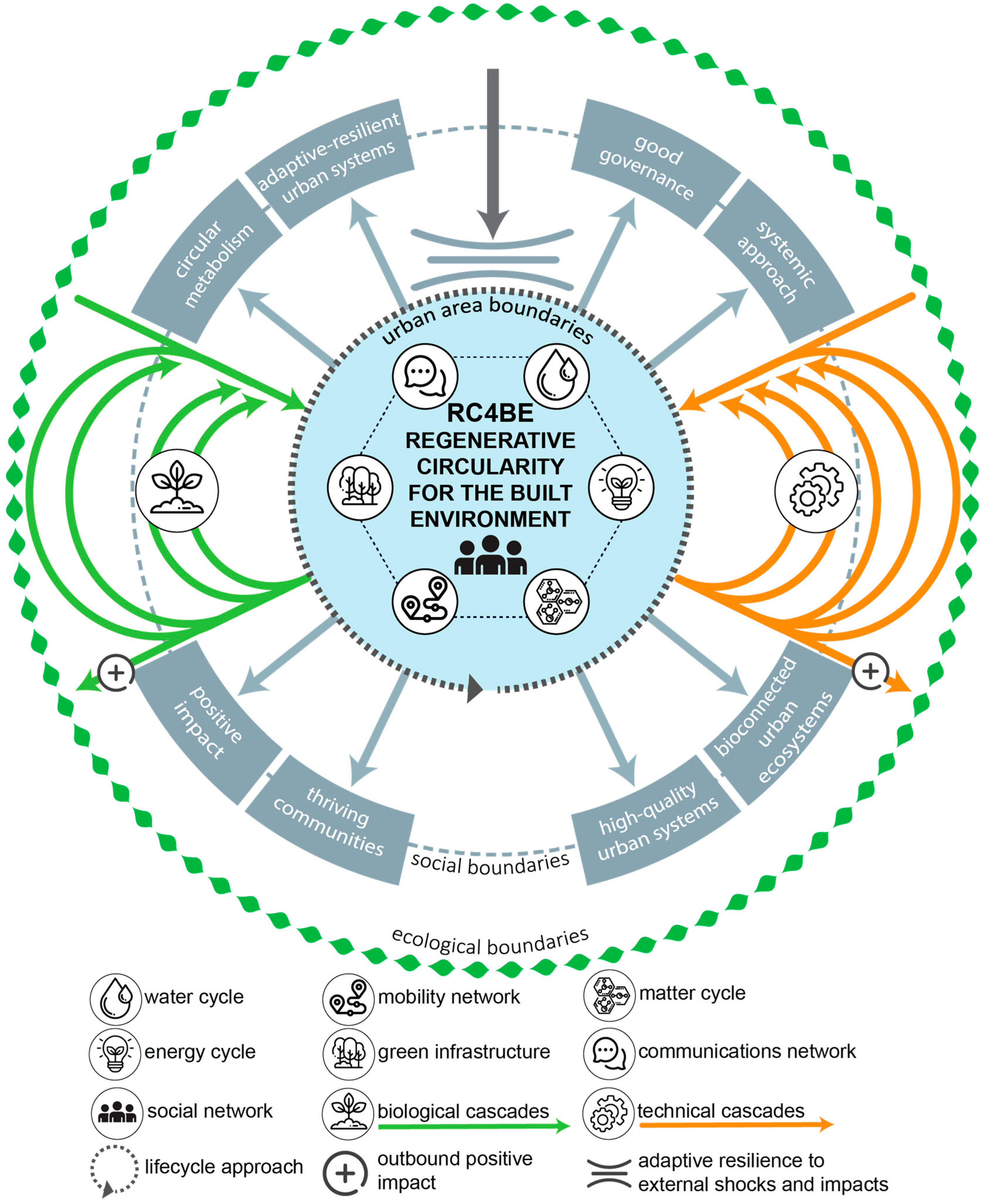

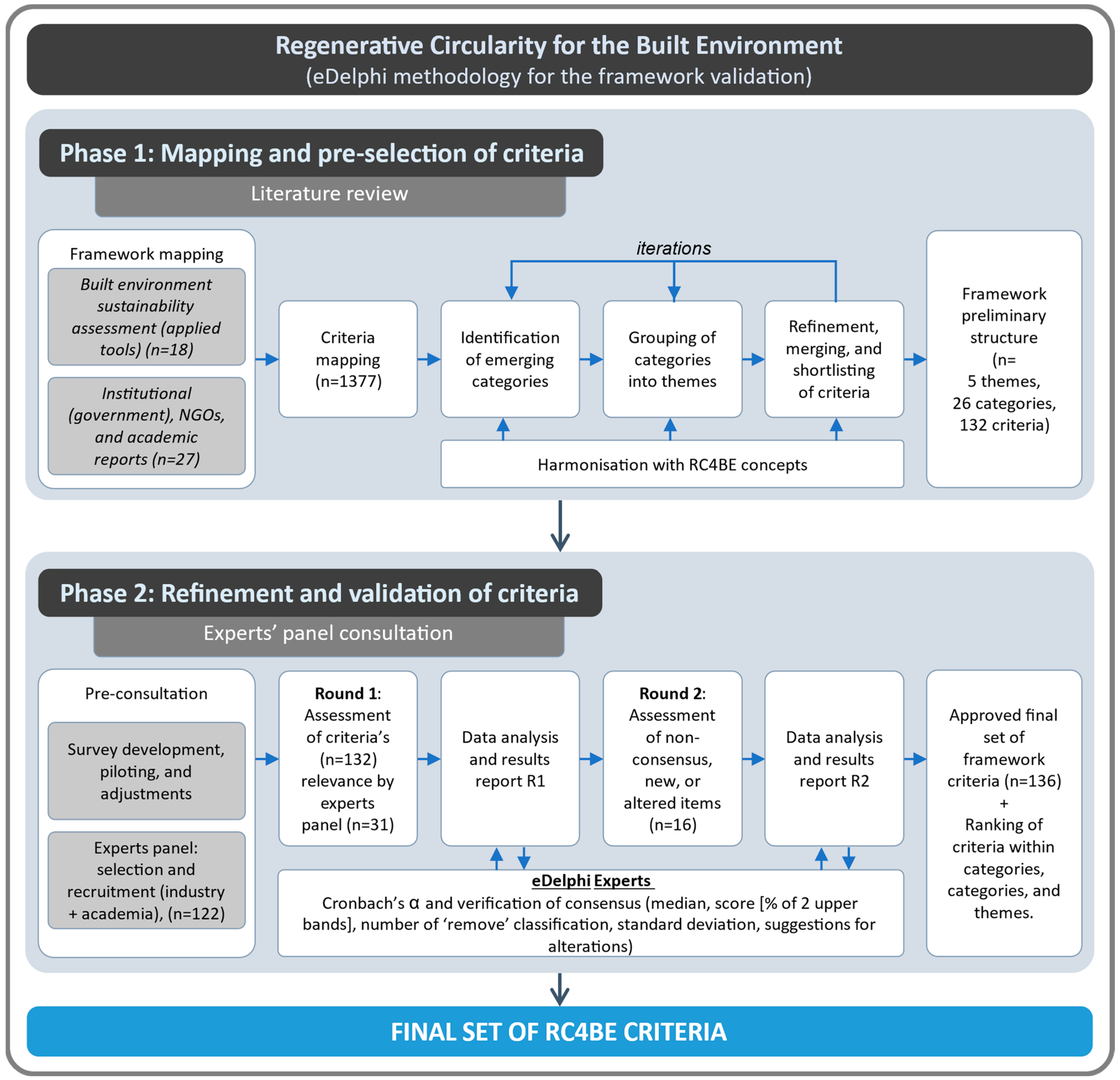
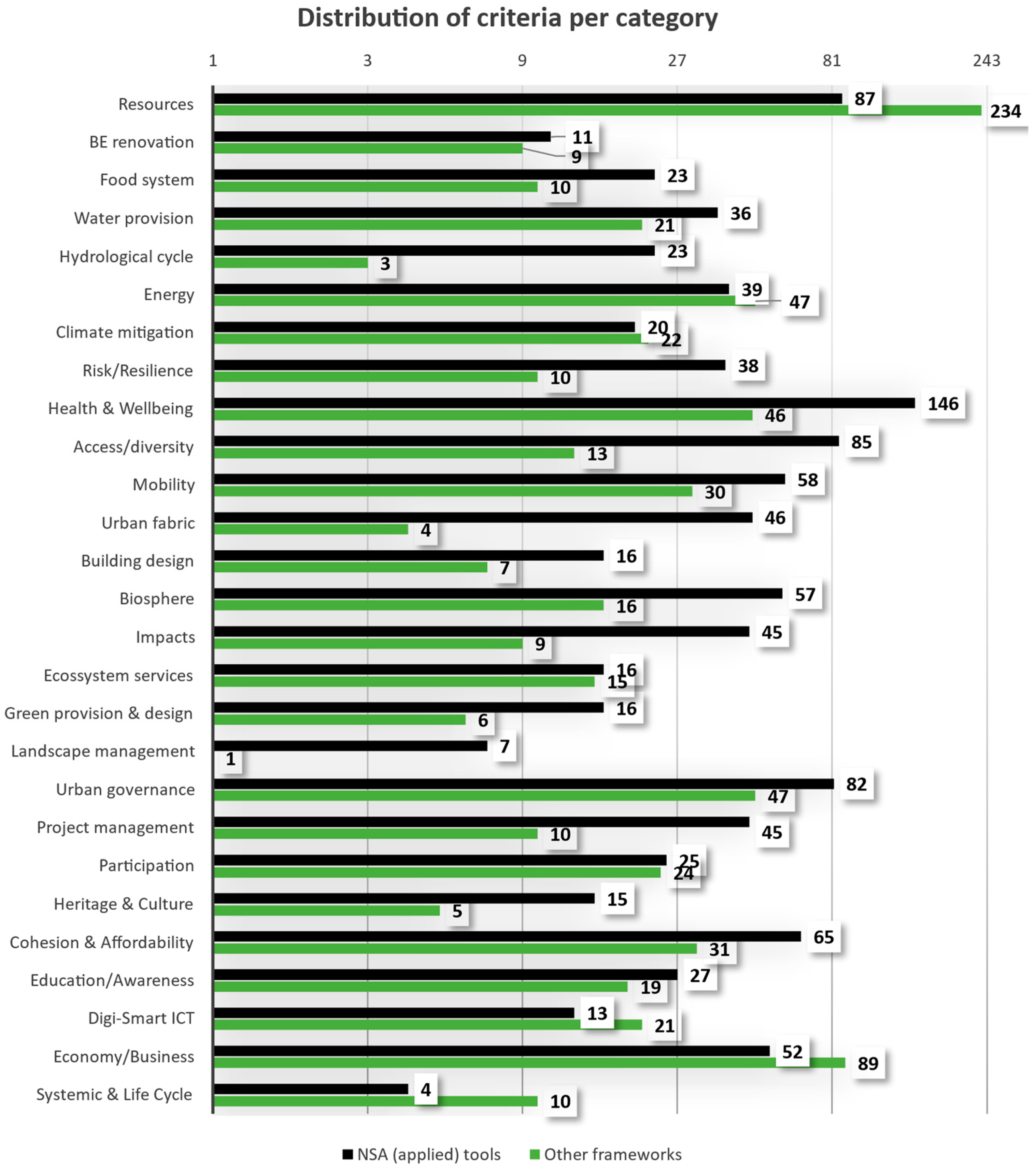
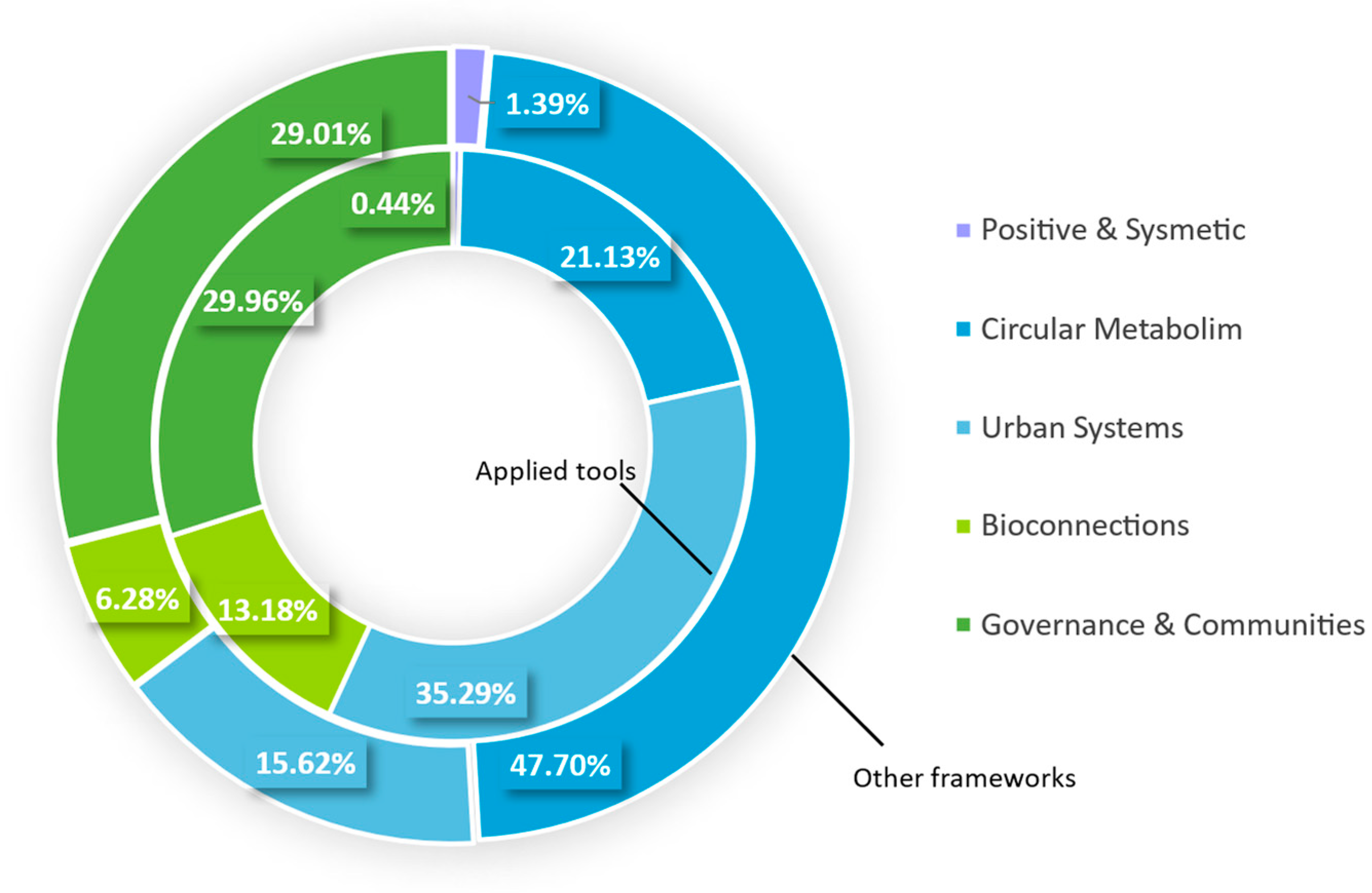
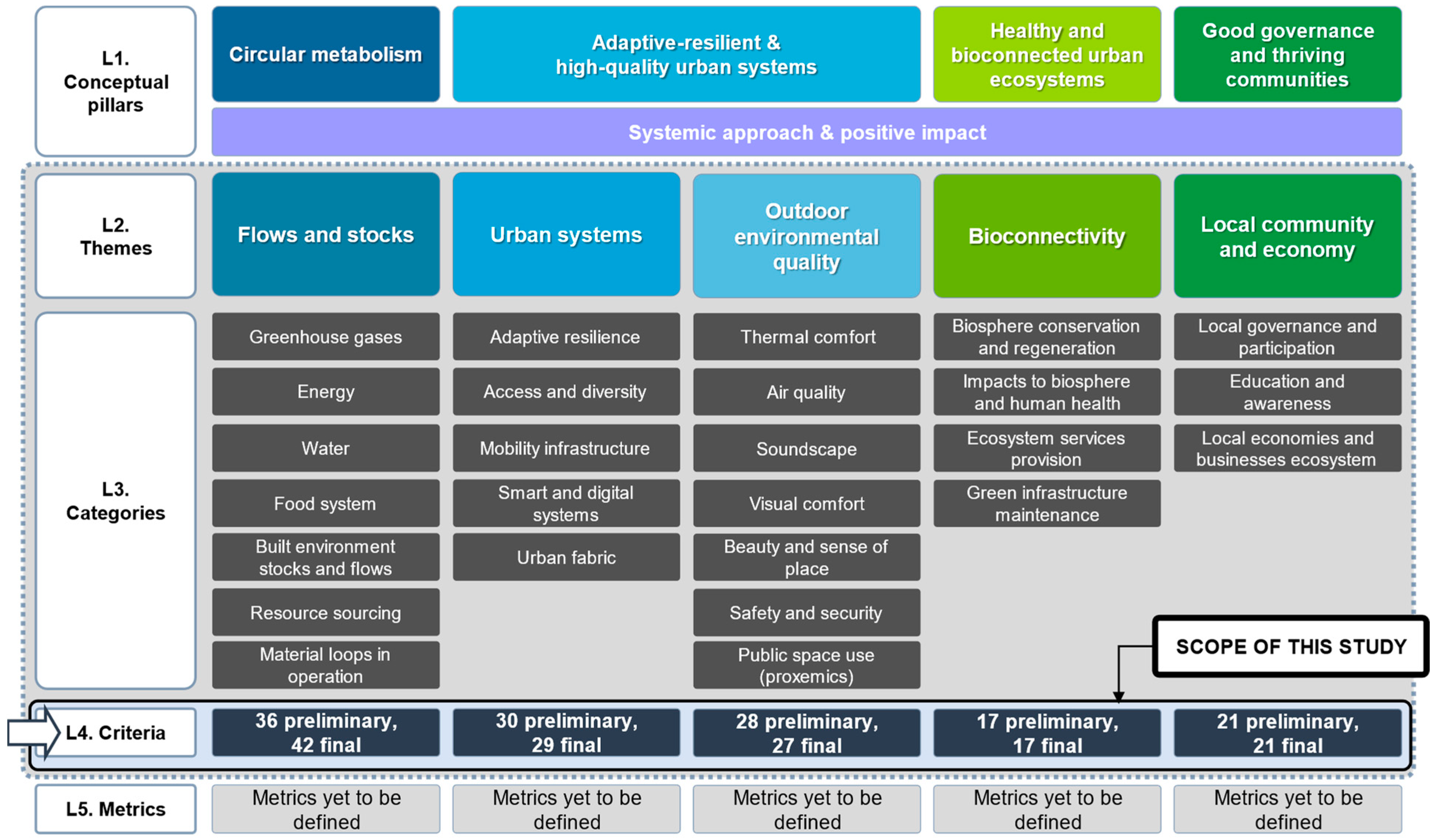
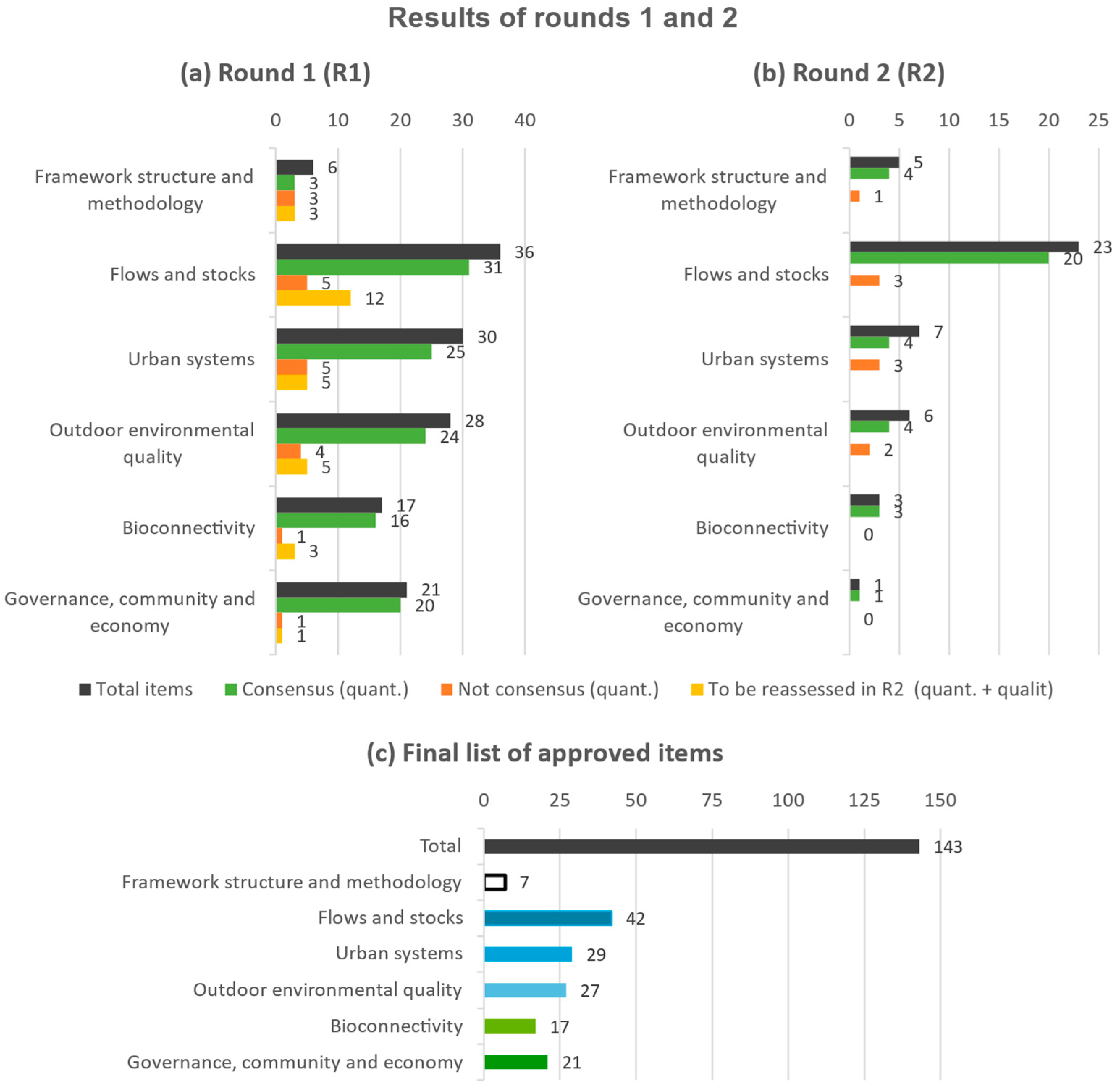
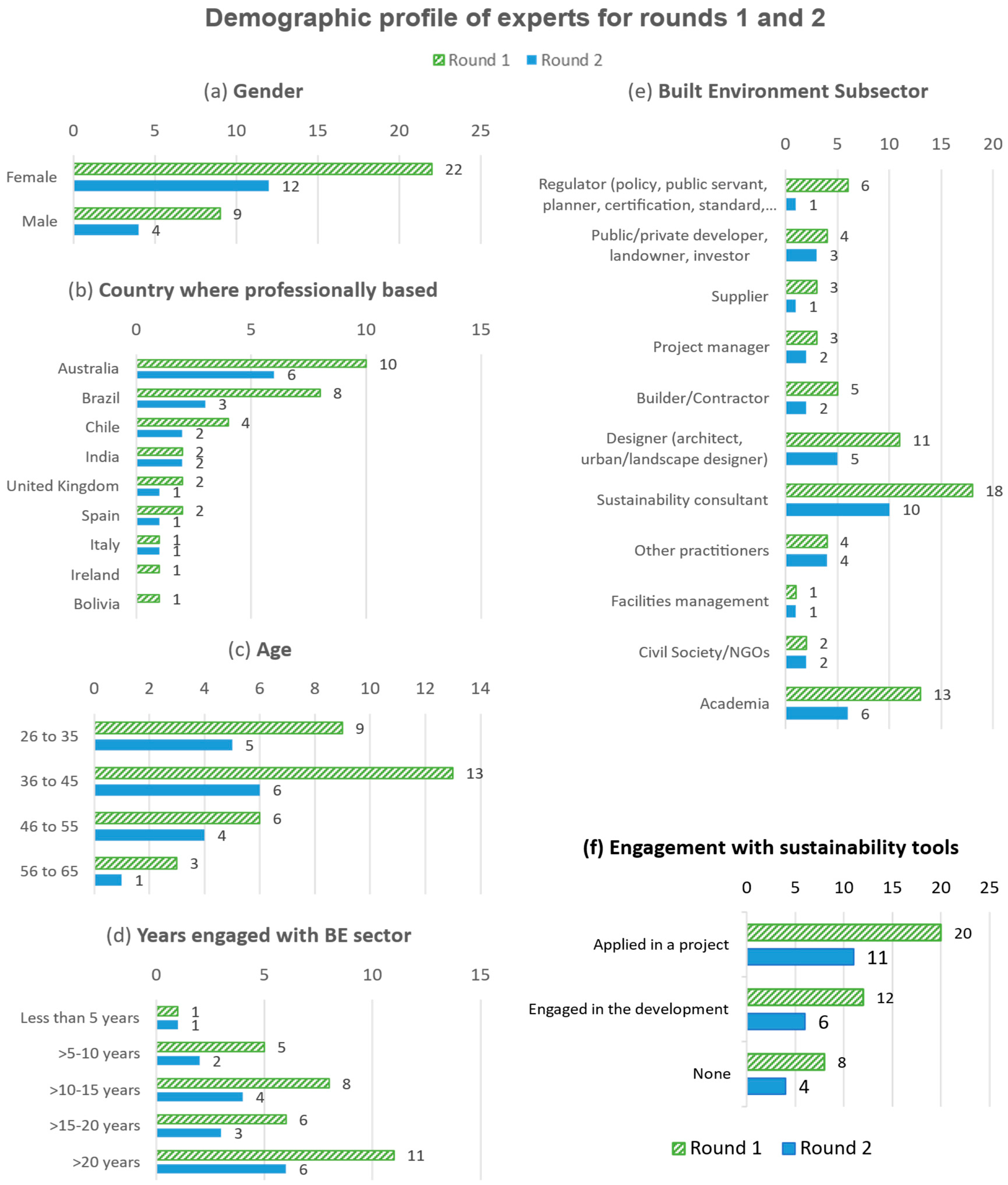
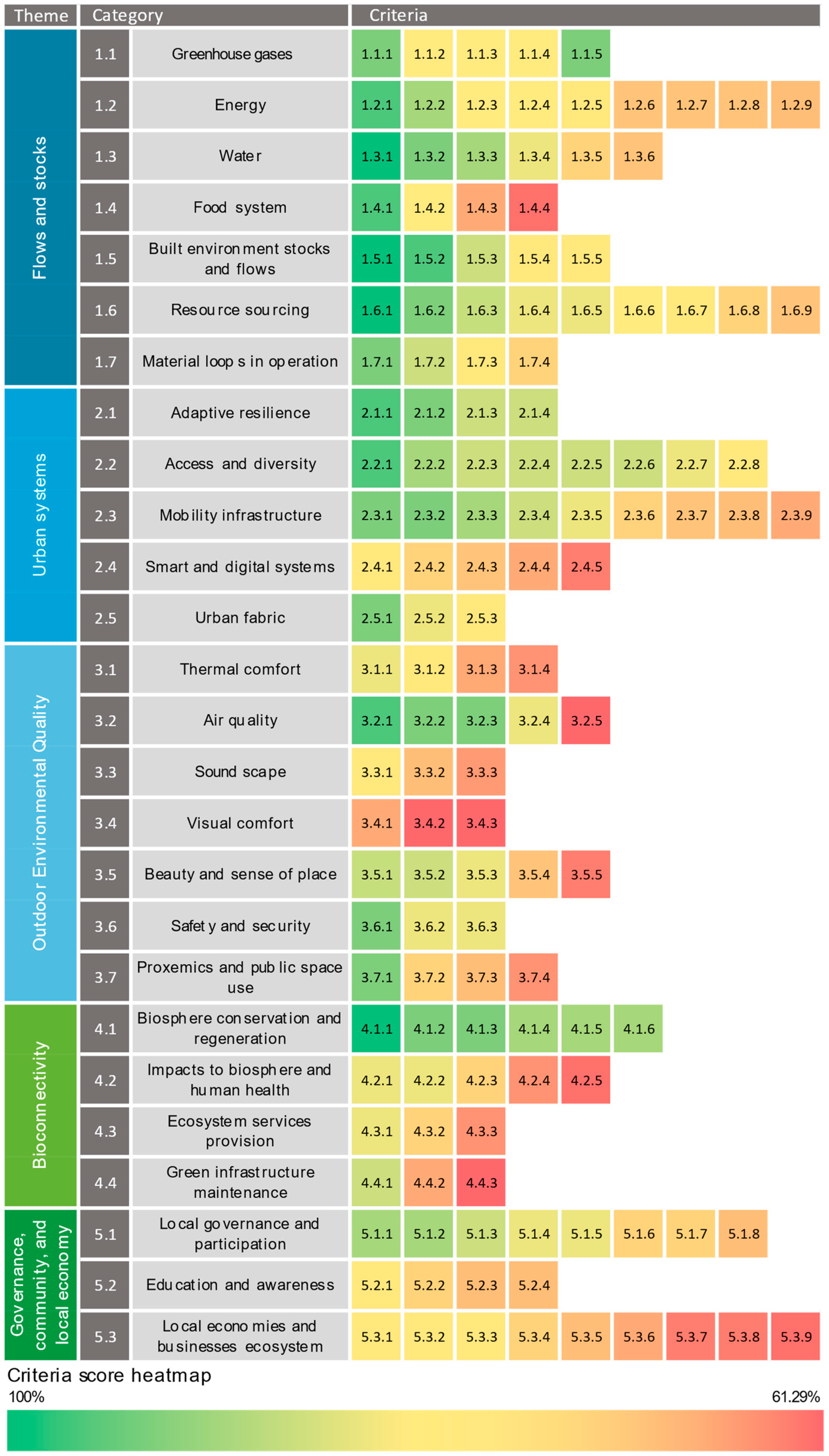
| Framework 1 | Ref. | External Validation 2 | Project Specific | Typology Specific | Beyond Resource Focus | Metrics |
|---|---|---|---|---|---|---|
| Circular Cities Assessment Framework | [29] | X | ||||
| Circular assessment framework for Spaarndammer tunnel, Amsterdam | [30] | X | X | X | ||
| London circularity indicators | [31] | X | X | |||
| Circular City Actions Framework | [32] | X | ||||
| Circle City Scan Tool | [33] | |||||
| Circular Economy in Cities Project Guide | [34] | X |
| Item | Round 1 | Round 2 |
|---|---|---|
| Demographics | 8 questions | N/A |
| Reliability check | Cronbach’s α ≥ 0.70 | |
| Structure and methodology questions | 5-point Likert-scale questions (1 strongly disagree, 2 somewhat disagree, 3 neither agree nor disagree, 4 somewhat agree, 5 strongly agree) and open-ended questions for comments. | |
| Structure and methodology consensus conditions | Median equal or greater than 4. 60% or more of experts selected the two upper bands. Standard deviation equal or smaller than 1.5. | |
| Criteria questions | 6-point Likert-scale questions (1 remove, 2 not at all important, 3 slightly important, 4 moderately important, 5 very important, 6 extremely important) and open-ended questions for comment, divided into the 5 themes. | 6-point Likert-scale questions (1 not at all important, 2 slightly important, 3 moderately important, 4 very important, 5 extremely important) and open-ended questions for comment, divided into the 5 themes. |
| Criteria quantitative consensus conditions | Median equal or greater than 5. Score ≥ 60% (sum of two upper bands %). Standard deviation ≤ 1.5. No more than one ‘remove’ response. | Median equal or greater than 4. Score ≥ 60% (sum of two upper bands %). Standard deviation ≤ 1.5. |
| Criteria qualitative consensus conditions | No relevant comment or suggestion for alteration | |
| Ranking of criteria within categories | N/A | From highest to lowest score within each category |
| Ranking of themes and categories | N/A | From highest to lowest score calculated from criteria’s score average. |
| Themes | Theme’s Score | General Ranking | Categories | Cat. Score | General Ranking | Aiming to Redesign and Transform Precincts and Neighbourhood… |
|---|---|---|---|---|---|---|
| Flows and stocks | 84.28% | 1 | Greenhouse gases | 86.25% | 7 | into climate positive urban systems. |
| Energy | 81.05% | 14 | into positive energy urban systems. | |||
| Water | 86.73% | 6 | into positive water urban systems. | |||
| Food system | 77.88% | 17 | for facilitated access to regenerative food systems. | |||
| Built environment stocks and flows | 89.03% | 3 | for a circular and resource effective built environment stock. | |||
| Resource sourcing | 84.79% | 10 | for a regenerative and responsible sourcing of built environment resources. | |||
| Material loops in operation | 84.73% | 11 | with adequate infrastructure for circular and regenerative management of resources loops. | |||
| Urban systems | 84.05% | 2 | Adaptive resilience | 91.13% | 2 | to be future-proof through the adaptive resilience of urban systems and buildings. |
| Access and diversity | 87.50% | 4 | for a diverse, just, and universal access to services and infrastructure. | |||
| Mobility infrastructure | 82.93% | 13 | to provide widespread and regenerative mobility systems. | |||
| Smart and digital systems | 73.71% | 23 | for the uptake of technology and smart solutions towards the betterment of life for all citizens. | |||
| Urban fabric | 86.02% | 8 | to foster compact urban fabrics with optimal levels of quality density. | |||
| Outdoor Environmental Quality | 78.59% | 4 | Thermal comfort | 75.81% | 20 | to improve the local microclimate and provide conditions for the use of outdoor spaces under different weather conditions. |
| Air quality | 85.81% | 9 | to regenerate the local air quality. | |||
| Soundscape | 74.53% | 22 | for adequate noise levels and a pleasant soundscape. | |||
| Visual comfort | 64.52% | 26 | to reduce visual discomfort and light pollution, while maintaining the local safety and security. | |||
| Beauty and sense of place | 79.60% | 15 | to strengthen the sense of place by fostering beauty in its diversity, and honouring local culture and heritage. | |||
| Safety and security | 87.16% | 5 | to offer an increased sense of security through their physical characteristics. | |||
| Proxemics and public space use | 78.23% | 16 | to increase the use of public spaces through diverse opportunities for citizens to reconnect, interact, and isolate. | |||
| Bioconnectivity | 81.31% | 3 | Biosphere conservation and regeneration | 93.08% | 1 | to conserve, regenerate, and maintain ecosystems and biodiversity inside and outside urban boundaries. |
| Impacts to biosphere and human health | 75.08% | 21 | to reverse the impacts and achieve a positive impact into human and ecosystems health. | |||
| Ecosystem services provision | 76.34% | 19 | to enable and maximise the provision of ecosystem services and nature-based solutions. | |||
| Green infrastructure maintenance | 73.12% | 24 | to maximise the provision and optimise the operation of green infrastructure interventions in urban areas. | |||
| Local community and economy | 77.48% | 5 | Governance and participation | 83.06% | 12 | to achieve inclusive and just community governance and activate the required urban transition enablers. |
| Education and awareness | 76.61% | 18 | to spread awareness and to function as sources of knowledge. | |||
| Local economies and businesses ecosystem | 72.89% | 25 | to enhance local economies and prioritise business models that generate positive impact. |
Disclaimer/Publisher’s Note: The statements, opinions and data contained in all publications are solely those of the individual author(s) and contributor(s) and not of MDPI and/or the editor(s). MDPI and/or the editor(s) disclaim responsibility for any injury to people or property resulting from any ideas, methods, instructions or products referred to in the content. |
© 2022 by the authors. Licensee MDPI, Basel, Switzerland. This article is an open access article distributed under the terms and conditions of the Creative Commons Attribution (CC BY) license (https://creativecommons.org/licenses/by/4.0/).
Share and Cite
Sala Benites, H.; Osmond, P.; Prasad, D. A Future-Proof Built Environment through Regenerative and Circular Lenses—Delphi Approach for Criteria Selection. Sustainability 2023, 15, 616. https://doi.org/10.3390/su15010616
Sala Benites H, Osmond P, Prasad D. A Future-Proof Built Environment through Regenerative and Circular Lenses—Delphi Approach for Criteria Selection. Sustainability. 2023; 15(1):616. https://doi.org/10.3390/su15010616
Chicago/Turabian StyleSala Benites, Henrique, Paul Osmond, and Deo Prasad. 2023. "A Future-Proof Built Environment through Regenerative and Circular Lenses—Delphi Approach for Criteria Selection" Sustainability 15, no. 1: 616. https://doi.org/10.3390/su15010616
APA StyleSala Benites, H., Osmond, P., & Prasad, D. (2023). A Future-Proof Built Environment through Regenerative and Circular Lenses—Delphi Approach for Criteria Selection. Sustainability, 15(1), 616. https://doi.org/10.3390/su15010616








